Twenty-five years ago, two passenger trains collided at Ladbroke Grove. The consequences for rail safety are still being felt today, as Paul Clifton explains.
In this article:
Twenty-five years ago, two passenger trains collided at Ladbroke Grove. The consequences for rail safety are still being felt today, as Paul Clifton explains.
In this article:
- The 1999 Ladbroke Grove rail crash killed 31 people and injured 417, leading to widespread changes in the UK rail industry's safety practices.
- The crash could have been prevented by an Automatic Train Protection system, and its aftermath highlighted issues with signal management and driver training.
- The introduction of the Train Protection & Warning System (TPWS) after the crash has been a key technological advancement, preventing many accidents by automatically applying brakes when trains approach red signals too quickly, and further technologies would help improve safety in the future.
October 5 1999 - one of the worst rail crashes of the last century: 31 people were killed and 417 injured. It was a watershed moment that changed the industry.
The collision at Ladbroke Grove was the second major crash on the Great Western Main Line in two years, following the Southall accident in September 1997. Both events could have been prevented by an operational Automatic Train Protection system.
The crashes damaged public confidence in the management and regulation of safety on what was still a newly privatised and fragmented railway.
And the effects have been long-lasting. In a quarter of a century, there has not been a fatality caused by a train passing a red light - a SPAD (signal passed at danger), even though the number of SPADs remains stubbornly close to 300 every year, with the Salisbury tunnel crash in 2021 the most serious recent example.
Ladbroke Grove led to a public inquiry, chaired by Lord Cullen. He produced two reports, which between them made dozens of recommendations.
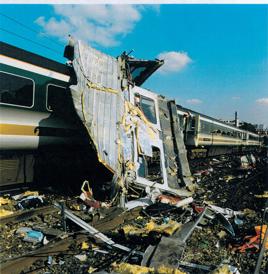
The crash
At 0806, a Thames Trains Class 165 heading from Paddington to Bedwyn collided with a Great Western High Speed Train from Cheltenham to Paddington. It happened at Ladbroke Grove, two miles west of Paddington. The combined speed on impact was 130mph.
The Thames driver, 31-year-old Michael Hodder, and 52-year-old Brian Cooper, driver of the Great Western service, were among the dead.
The leading carriage of the diesel multiple unit was largely destroyed. The fuel it was carrying ignited, leading to a series of fires - particularly in a carriage near the front of the HST, which was substantially burned. Most of those who died were in the Bedwyn train.
Driver Hodder, who came from Reading, passed a red signal (SN109) on an overhead gantry. The preceding signal had displayed a single yellow, indicating a red signal ahead.
Hodder was inexperienced, having qualified only two weeks before the crash.
The subsequent inquiry identified deficiencies in his training - including not being notified of recent SPAD incidents at the same signal. SN109, on a bi-directional track, had been passed at danger eight times in six years.
The crash occurred on a clear autumn morning. The sun would have been low in the sky, behind Hodder, meaning that the sunlight would have reflected off a yellow aspect signal, reducing visibility.
The inquiry considered that the poor placement of the signal meant it was more probable than not that the inadequate visibility of SN109, along with the positioning of other signals on gantry 8 and the reflections of sunlight, led Hodder to believe he was able to proceed.
Several years after the crash, Thames Trains was fined £2 million after admitting breaches of health and safety legislation. Network Rail, the successor organisation to Railtrack, was eventually fined £4m in 2007.
Signal SN109 was brought back into operation in 2006.
Lord Cullen had previously led inquiries into the Dunblane massacre of schoolchildren in 1996, and the Piper Alpha oil platform disaster of 1988. His inquiry found that rail safety statistics had not worsened after privatisation, nor had it been detrimental to safety.
But it did reflect concerns about fragmentation of the industry creating new complex interfaces, and noted that the quality of safety leadership varied between the new organisations.
Cullen found that an emphasis on meeting performance targets had diluted the perceived importance of safety, with larger fines for poor punctuality than for breaches of safety regulations.
Train Protection & Warning System
Cullen’s report detailed issues with the signals, following ineffective management. It referred to how “so many apparently good people could produce so little action” and heard of “a seemingly endemic culture of complacency and inaction”. Driver training was heavily criticised.
The Thames Turbo train had been fitted with an Automatic Warning System, which required the driver to acknowledge a warning each time a signal not at green was approached. If an Automatic Train Protection (ATP) system had been fitted, it would have applied the brakes to prevent the train going beyond a red signal.
National adoption of ATP had been recommended after the 1988 Clapham rail crash, but it had been dropped because the benefits were considered insufficient to justify the cost.
The Cullen inquiry decided that was a correct choice and that the cost would not have justified the fitting of ATP on Thames Trains.
Only two weeks before the crash, the Health and Safety Executive had announced the adoption of Train Protection & Warning System (TPWS) - a lower-cost safety mechanism which could stop most trains within the overlap distance of a red signal.
This remains in use throughout the UK. When a train approaches a red signal too fast, it automatically initiates a brake demand after passing a pair of electronic loops in the track (often described as looking like grids or electric toasters). It is not designed to prevent a SPAD, but to reduce the consequences of one.
“This was the biggest and most dramatic change,” says Network Rail Safety and Engineering Director Martin Frobisher.
“This interim technology has outperformed all expectations.
“The rollout of TPWS at junction signals, where this sort of collision can occur, provided us with a technology solution. If the signal is at danger, TPWS will apply the brakes, even if the driver makes a mistake.
“The industry adopted this in a pragmatic way. This was a simple but clever development that we could fit nationwide over just a few years. It wasn’t the perfect technology. But the perfect technology would have taken decades to introduce, by re-signalling everything.”
At the time of the Ladbroke Grove crash, the European Train Control System (ETCS) was already in development. Twenty-five years on, it is only now being rolled out on the East Coast Main Line. And there are no firm plans for it to be used on other lines.
“That’s the ultimate technology. To introduce full train protection, you have to re-signal the line,” says Frobisher.
“A vast investment both on the line and in train cabs. That would have made it slow and unaffordable for the nation. If you wait for perfection, you wait too long.
“Ladbroke Grove was a ‘this cannot happen again’ moment, where we recognised the need to have protection spread rapidly across the network, rather than a phased approach as signals came up for renewal over the coming decades.”
If TPWS is the most successful life-saving change, what else has been done to tackle the underlying issues that led to Driver Hodder passing a red signal?
“Everyone who worked on the railway can recall exactly where they were that day,” says Frobisher.
“There are a few events in life where you can place that moment. You never forget it.
“At the time, we were complacent about signal SN109, and that type of signal. Today, we do signal overrun risk assessments with a different degree of rigour. If we get repeat SPADs at a signal, we really try to get to the bottom of what the factors are.
“It has changed out of all recognition compared with before Ladbroke Grove.
“In the last few years, the industry has developed a tool called RAATS - the Red Aspect Approach Tool.
“This looks at timetables to lower the number of occasions when a train is scheduled to approach a red signal. If you run the network with fewer red signals, then the number of SPADs goes down.”
New safety structure
Lord Cullen’s recommendations led to the creation of three separate safety organisations with railway responsibility.
The Rail Safety and Standards Board (RSSB) was formed in 2003, and the Rail Accident Investigation Branch (RAIB) followed in 2005. The Railway Inspectorate, although it had existed since 1840, was altered and today sits within the Office of Rail and Road. It is separate from the Health and Safety Executive.
Following the model of the aviation industry, this separated the setting of standards, accident investigation and regulation.
After the crash, the railway also embraced CIRAS (the confidential incident reporting and analysis service), which continues today as a way to protect people who raise health, safety and wellbeing concerns.
“That tripartite process has served the industry well,” believes Andrew Hall, Chief Inspector of Rail Accidents, who has been with the Rail Accident Investigation Branch since its inception in 2004.
“Ladbroke Grove defined a structure where RSSB sets the standards, the industry manages risk, the regulator checks the risk is managed to a level that is as low as reasonably practicable, and an independent investigator looks into incidents.
“There has been a dramatic drop in risk over the period since then. Some of these gains have come by technology. Some have come from a better understanding of risk. Some have been gained by a structure that better looks at accidents and learns from them.”
Hall points to two key factors: independence of the investigator, and the fact that it never points the finger of blame.
“When organisations investigate themselves, often the people doing the work are not doing it as their day job. That affects the depth and width of any investigation.
“Then there’s the issue of using people who were in some way involved - they may find it difficult to make criticisms of their bosses. Being seen as independent also reassures the travelling public.
“We do a safety investigation. There are other kinds of investigations, and they can go very deeply. But they tend to answer specific legal questions about blame. Having no blame leads to candidness - you can interview people who have their witness statements protected.
“Our role is to avoid the same thing happening twice. We are permanent, and our sole purpose is to investigate accidents. And nothing else.”
RAIB is not large - 44 staff, split between Derby and Farnborough. In 2023, it published 14 full incident reports. So, how can success since Ladbroke Grove be quantified, given you can’t count lives not lost?
“If you go back ten or 15 years, we did a lot of work around level crossings,” says Hall.
“There are now fewer issues at level crossings. The same with track worker investigations - red-zone working is now more or less eliminated by Network Rail.
“I would argue it has worked well.”
Future gains
“I don’t place much focus on the fact that the Rail Safety and Standards Board was a product of Ladbroke Grove,” says RSSB Chief Executive Mark Phillips.
“To keep our relevance in the industry, we have to be more forward-leaning and think about future risks.”
There are around 290 SPADs a year. When an overall reduction in train mileage is taken into account, that frequency has not changed much in several years.
“They’ve changed a bit in nature - a predominance of empty coaching stock,” says Phillips
“In many respects, drivers are working at their maximum human capability. So, to manage risk, there will have to be an adoption of more technology and different working arrangements.
“We are developing a future train protection strategy. An associated risk of SPADS is overspeeding, which we are particularly concerned about.
“Better understanding of human factors is a big area of our work, including driver fatigue and how to maintain concentration.
“We are currently rebuilding the industry safety database to better collect all the safety incident data across the entire network. That should help understand patterns in the data and drive responses to those.
“We are looking at enhancing TPWS to give real-time information to drivers about the permitted speed.
“If you have a modern car, it will display the speed limit wherever you are. It should not be difficult or expensive to have that capability on a train. It seems a fairly obvious thing to do, while we think our way forward to the eventual goal of ETCS.
“Let’s face it: the industry is going to be cash-strapped for ever. In a 30-year horizon, ETCS is the destination, but there’s no clear funding path for that. No agreed strategy beyond the East Coast Main Line.”
There is inevitably tension between the different elements of the railway: train operator, infrastructure owner, regulator, safety standards, and investigators. The tension is often driven by cost constraints, especially since the pandemic.
“As someone who works on railway safety, having a knowledgeable and challenging regulator is a good thing,” says NR’s Martin Frobisher.
“I appreciate that we have a dedicated rail safety inspectorate: people who understand the railway.
“If the safety inspectorate ever found itself merged into the wider Health and Safety Executive, that would be a setback.
“Accidents are quite rare on the railway. They’re very regular in construction. I imagine that if you prioritised how many lives are saved, you might not give rail the focus it gets today, and not with the degree of specialist focus we see at ORR. Working with people who understand the issues helps to drive railway safety.”
Never forget
“Twenty-five years is a long time,” says Frobisher.
“It’s important that we don’t lose the lessons of Cullen. This is about corporate memory, and the need for a new generation of railway engineers to be as focused on SPADs as we have all been. Because we all lived through Ladbroke Grove, but there are fewer of us around these days.
“We’ve made great progress. But don’t be complacent. Don’t forget.”
A passenger’s perspective
Alan Macro, from Theale in Berkshire, survived the crash. He was physically unhurt, but says he suffered from Post Traumatic Stress Disorder (PTSD).
“The railway has become a lot safer since the Paddington crash - mainly because of TPWS [Train Protection & Warning System],” he tells RAIL.
“However, I thought TPWS was an interim solution. I am disappointed that more progress has not been made installing ERTMS, the European Rail Traffic Management System.
“We’ve lost Automatic Train Protection on the Great Western Main Line since electrification, though that was never installed on the class of train that caused the crash.
“I am also concerned that level crossings continue to be a serious safety risk. No progress on making them safer has taken place since the Ufton Nervet crash, which was not far from where I live.
“My other big concern is the combination of Network Rail’s knowledge of the state of rail assets and climate change. This led to the Stonehaven derailment, and there have been several partial collapses of embankments and cuttings recently that I think could have led to similar incidents.”
Login to continue reading
Or register with RAIL to keep up-to-date with the latest news, insight and opinion.


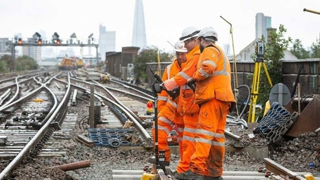
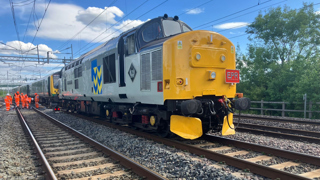
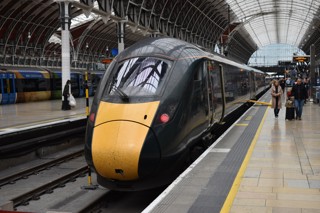
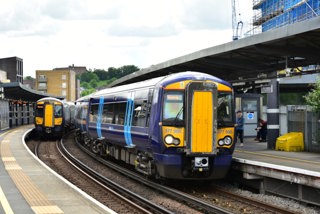
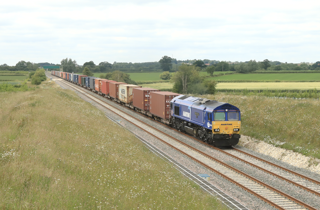










Login to comment
Comments
No comments have been made yet.